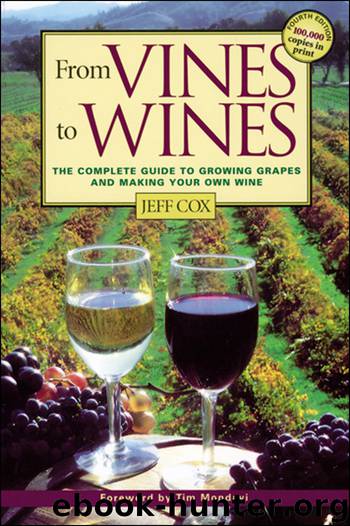From Vines to Wines by Jeff Cox & Tim Mondavi

Author:Jeff Cox & Tim Mondavi
Language: eng
Format: epub
Publisher: Storey Publishing, LLC
Published: 1999-02-28T05:00:00+00:00
Adding Sugar to Must
As a very rough approximation, the amount of alcohol in the finished wine will be a little more than half the Brix. In many lackluster years, growers in the northern half of the country will find that Brix reaches only 17, 18, or 19 — or less if the weather has been disastrously cold and cloudy. The grapes just don’t ripen. That’s one reason why the right variety, one that ripens well in your climate, is so important to choose for the backyard vineyard. Low-sugar grapes produce low-alcohol wines: a must of 17 Brix, for instance, will yield a dry wine of just a little more than 9 percent alcohol. Low-alcohol wines are soft, prone to wine disorders and to infections by organisms that would otherwise be discouraged by adequate alcohol content. It makes sense to add sugar to the must in order to produce wines of 12.5 percent alcohol — the optimum for a fine wine.
For the first few years that I made wine, I avoided adding sugar, or chaptalizing, as it’s called in France, where there are laws against it. I thought that if the French eschewed the practice they had good reasons. And they do: Grape-growing areas of France are planted with vines that almost always reach sufficient sugar for an alcohol content of about 12 percent. Besides, I thought, white sugar is terrible, tooth-rotting, body-buzzing stuff, and I didn’t want it in my wine.
I’ve since learned that although I may add sugar I don’t get it in the finished wine. It’s entirely converted to alcohol by the yeasts — the selfsame ethyl alcohol that they produce from the natural sugars in the grape. There are no flavor components in pure sugar to affect the taste of the wine either way. All it does is raise alcohol toward desired levels.
Pure, white table sugar is perfect for this task. Wine yeasts are excellently equipped with the know-how to convert almost every molecule to alcohol. This sugar, sucrose, is cheap, and every bit as good as dextrose, fructose, and other kinds of sugar. In fact, it’s superior to most and costs less. Exotic sugars may or may not be suited to the taste of your yeast. Grape sugar, or d-glucose, is ideal; so is fructose. Maltose, lactose, and others shouldn’t be used. When sucrose, ordinary table sugar, is dissolved in water (which comprises most of the grape must, of course), it dissociates into d-glucose and d-fructose. Wine yeasts go right to work on it. (A lot of beer makers go wrong by adding sucrose to their malt. Beer yeasts have trouble converting sucrose to alcohol, and that’s why so much homemade beer has an unpleasant, sweet aftertaste.)
Only pure white table sugar should be used. Brown sugar, “raw” sugar, or turbinado sugar all contain molasses, which will add nothing to a fine wine but a suspicious taste.
Of course, there’s something to be said for a natural wine — one with only 11 percent alcohol made from a must with a Brix of 19.
Download
This site does not store any files on its server. We only index and link to content provided by other sites. Please contact the content providers to delete copyright contents if any and email us, we'll remove relevant links or contents immediately.
101 Whiskies to Try Before You Die by Ian Buxton(44802)
World's Best Whiskies by Dominic Roskrow(44740)
Whiskies Galore by Ian Buxton(41882)
Craft Beer for the Homebrewer by Michael Agnew(18144)
Right Here, Right Now by Georgia Beers(4127)
Not a Diet Book by James Smith(3339)
Water by Ian Miller(3129)
The Coffee Dictionary by Maxwell Colonna-Dashwood(3067)
Kitchen confidential by Anthony Bourdain(3010)
Coffee for One by KJ Fallon(2567)
Smuggler's Cove: Exotic Cocktails, Rum, and the Cult of Tiki by Martin Cate & Rebecca Cate(2473)
Superfood Smoothie Bowls: Delicious, Satisfying, Protein-Packed Blends that Boost Energy and Burn Fat by Chace Daniella(2388)
Talking as Fast as I Can by Lauren Graham(2386)
Beer is proof God loves us by Charles W. Bamforth(2374)
Bourbon: A Savor the South Cookbook by Kathleen Purvis(2246)
A Short History of Drunkenness by Forsyth Mark(2234)
Eat With Intention by Cassandra Bodzak(2156)
Cocktails for the Holidays by Editors of Imbibe magazine(2082)
Colombia Travel Guide by Lonely Planet(2066)
